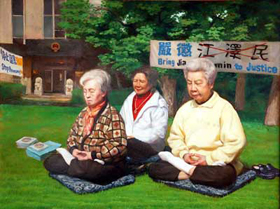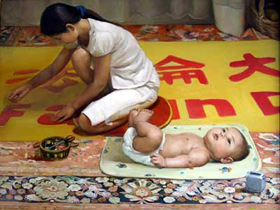Reporter: Zhu Qingming, a reporter for Zhengjian.org/PureInsight.org
Dong: Mr. Dong Xiqiang, painter
Reporter: Could you please tell us how you became a Falun Gong practitioner?
Dong: When I lived in Mainland China, my parents-in-law were practitioners of Falun Gong. At that time, I was very busy with my work. I did very little personal cultivation and rarely practised the exercises. But I did do a lot of things related to Falun Dafa. Things were very tense in Mainland China around July 20th, 1999. Whatever there were things that local Falun Gong practitioners needed to do but couldn’t, I would try to help out. In that respect, I could say that I was practising Falun Dafa in a way, but in fact I had only one foot in the door! I only practised Falun Dafa in earnest after Master gave the lecture "Teaching the Fa at the Discussion on Creating Fine Art." Master's lecture moved me immensely. I felt that I should be doing some concrete work in Falun Dafa. When I painted in the past, I never understood completely how I was supposed to paint. Now I have gained a complete understanding and feeling on how to do an oil painting. I have come to understand things that I didn’t know before after listening to the teachings taught in Falun Dafa.
Reporter: How did you conceive the ideas in your paintings?
Dong: The paintings "Calling for Justice" and "Banner" were derived from my own experience in my daily life. I have been participating in various Falun Dafa activities and have been making observations. In the process of making my own observations, I discovered things that I wanted to depict in my paintings. One has to have experienced certain feelings in order to create a piece of art. I don’t think I enjoy depicting a major scene. My paintings are very much based on people’s daily lives. They are all about the actions of my fellow practitioners around me.
I used to work for a newspaper. After I came to the United States, I participated in many major activities organised by Falun Dafa practitioners. In preparation for those activities, many local practitioners and I often started making Falun Dafa banners after we got off work and didn’t stop until the early hours of the morning. I watched how young and elderly practitioners worked together, even young children helped out. That moved me a lot. Many of the minor details of how practitioners have worked to spread the practice are very touching. Every painter has his own way of depicting things in his paintings. My method is to use my paintings to express the beauty that I have observed in things that seem very ordinary. In "Calling for Justice" I depicted some elderly ladies who have been practising sitting meditation in front of the Chinese Embassy in Washington D.C. for years. I went to watch them every day for a while. They have overcome so much and have done things that very few people are able to do. They go to the embassy every day no matter what, and I was very moved by them. I thought that they should be recorded in a painting. The people depicted in that painting are actual people. My original painting showed a dark background. Later I changed it to a lawn and some trees were added. There is a pair of shoes shown on the right hand side of the painting. There is a story behind that pair of shoes. The shoes belong to the elderly practitioner depicted in the painting wearing a yellow sweater. The shoes were given to her by another elderly lady who had passed away. The elderly practitioner wearing the yellow sweater later told me that she once had a dream. In the dream, the elderly lady who had given her the shoes came to her. She appeared very young again. She said that she was doing quite well on the other side. She asked the practitioner to pass a message to her husband and daughter, that they must be diligent in their cultivation and never to abandon the practice. When I did my painting, I hadn’t known about the story. But the pair of shoes were depicted in the painting inexplicitly. This was perhaps an arrangement.
 |
| Dong Xiqiang, “Calling for Justice,” Oil Painting, 48 inches X 36 inches (2004) |
In the "Banner", I included an infant in the middle of the painting. I felt that the inclusion of the infant added more life to the painting. I showed the expression in the eyes of the infant in vivid details. Beside the infant is an audio device that practitioners call “Small Bee” that plays the lectures of our practice and the exercise music. In a way, it depicts the continuance of Falun Dafa and its glory. The painting depicts a very realistic scene from real life.
 |
| Dong Xiqiang, “Banner", Oil Painting, 48 inches X 36 inches (2004) |
At present I am concentrating on paintings that depict the persecution of Falun Gong practitioners in Mainland China, which I feel is a theme that I need to do more paintings on. Right now whenever I want to do something, I will do it right away. Sometimes I do think about the composition of a painting. But it is not real until I can put it down on paper. Painting is also a part of my cultivation. It took me two and a half months to complete my first batch of paintings, and that speed was quite amazing. In that instance, I did not think of anything else but to proceed with the painting. What was not correctly depicted was amended or repainted later on. That was the way I elevated myself.
Reporter: What do you think of traditional oil paintings?
Dong: I have always liked classical oil paintings and disliked the works of Vincent van Gogh and Pablo Picasso. In my work as a painter, I have always concentrated on studying traditional classical oil paintings. I have copied some classical oil paintings and studied classical paintings in order to understand what constitutes a traditional and classical painting. What is a genuine classical painting? I feel such a painting should have rigorous sketching, decorative colours, and well-balanced compositions. These three factors make up a classical painting. Looking at the classical paintings of the masters, you will find all these three factors in every painting. Of course a painting must also illustrate its subject vividly as if they have come to life.
* * *
You are welcome to print and circulate all articles published on Clearharmony and their content, but please quote the source.










 more ...
more ...